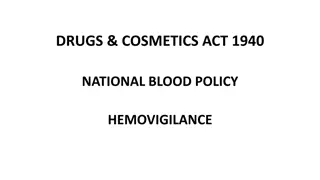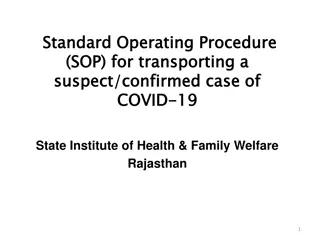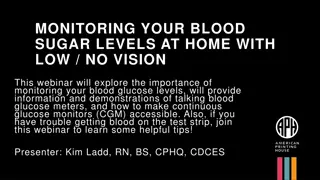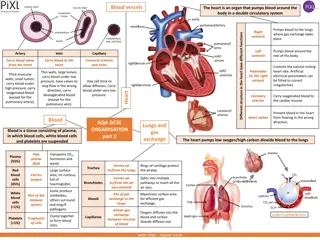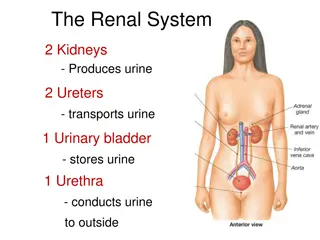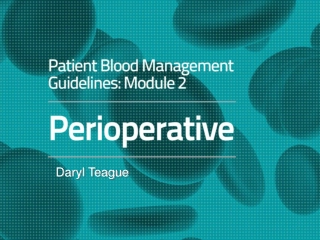Comprehensive Training for Transporting Blood Products Internally
This training module covers the essential aspects of transporting blood products internally, including who is permitted to handle blood, what responsibilities they have, and how to ensure safe transportation. It outlines the staff members permitted to transport blood products and the specific guidelines for handling different types of blood products. The content emphasizes the importance of proper documentation, regular training, and compliance with established procedures to maintain quality management in healthcare settings.
Download Presentation

Please find below an Image/Link to download the presentation.
The content on the website is provided AS IS for your information and personal use only. It may not be sold, licensed, or shared on other websites without obtaining consent from the author. Download presentation by click this link. If you encounter any issues during the download, it is possible that the publisher has removed the file from their server.
E N D
Presentation Transcript
Training For Transporting Blood Products Internally
OBJECTIVES 1. Who is permitted to transport blood at your facility 2. What you need with you when you retrieve blood products 3. Your responsibilities when signing for a blood product 4. How long blood may be in transit 5. How to handle blood safely
Who needs this training? The Institute for Quality Management in Healthcare (IQMH) requirements state that ALL staff that transport blood from the Transfusion Services to a Nursing Unit have regular training. Policies, processes and procedures shall be established for: a. training of personnel involved in the packing and transportation of blood components and blood products b. documentation of training c. internal assessment to ensure compliance with established procedures 9.5.1 Reference: Canadian Society for Transfusion Medicine Standards for Hospital Transfusion Services, Version 4, Ottawa, ON: Canadian Society for Transfusion Medicine, April 2017:5.7.1.2
Staff permitted to transport blood products are: Ward clerks Porters Registered Practical Nurses (RPN) Registered Nurses (RN) <Add any others that may be permitted or designated as not being permitted at your facility>
Blood Products: Any item supplied by the Transfusion Services Red Blood Cells If it is not being transfused, it can not be out of the fridge for more than 60 minutes
Blood Products: Any item supplied by the Transfusion Services Platelets Must stay at room temperature at all times
Blood Products: Any item supplied by the Transfusion Services
Before coming to the laboratory: You Must: Obtain printed Patient ID, such as a patient label/requisition, that clearly shows the patient s full name and one other unique identifier Ensure you are wearing your hospital ID badge Ensure you know what blood product you are picking up The TM lab will NOT issue product if any of the above are missing
On arrival at the laboratory: Present the patient ID (label or requisition) to the lab staff. Provide the lab staff with your ID Providing the Patient ID will ensure that the correct product is issued and sent with you If no lab staff available proceed to designated acceptable storage container of blood product
Verify Patient ID by: Using the Patient ID (label or requisition) : Compare correct patient name and one other unique identifier on the issue voucher/tag/label or card, attached to the blood product If the information is not the same DO NOT REMOVE FROM LAB Inform the lab staff of the discrepancy
Verify the blood product by: Comparing the Patient ID (label or requisition) : Compare correct product has been prepared for transporting up to clinical unit like Red Blood Cells Plasma Platelets Other products If no lab staff is available then verify using the patient ID (label or requisition) to : Compare the blood product number The Blood Group (if applicable) If there is a discrepancy DO NOT REMOVE FROM LAB Inform the lab staff of the discrepancy
If You Agree that the Information on All Documents is Identical The lab staff and you will sign the issue documentation The lab staff will give you the blood product You are ready to take blood to clinical unit If there is no lab staff available: Sign the issue documentation with another qualified staff member
Dos and Donts DO: take the blood product directly from the lab to the clinical unit in the container in which it was issued to you DO: Ensure that you hand the blood product over to patient care area staff DO NOT exceed 10 minutes for transit time from the lab to the clinical unit DO NOT take blood products through the cafeteria, outside the building on your way to the clinical unit Blood products MUST NEVER be placed in any fridge outside of the lab or near a heat source
Use good hand hygiene after handling blood products: Before: Proceeding to your next duty Eating Drinking Smoking Applying cosmetics
If at any time you notice that a blood product is leaking: Place the product in a biohazard bag Transport the blood product back to the laboratory if this can be done safely Wash your hands thoroughly, remove any contaminated clothes (obtain a set of hospital scrubs to wear) Notify the TM lab for other directions blood must always be accounted for
If you are asked to return a blood product to the laboratory: Take the blood product directly to the laboratory as quickly as possible The product may be reissued for another patient if returned back into the lab within 60 minutes of issue and is at acceptable temperature Hand the product over to a member of the lab staff i.e. ensure someone is aware you have returned the blood There are time and temperature limits for blood products to be out of the special refrigerators in the lab
Any questions or suggestions Contact the Laboratory/Transfusion Service <Enter contact information here>











